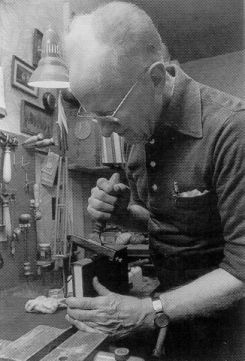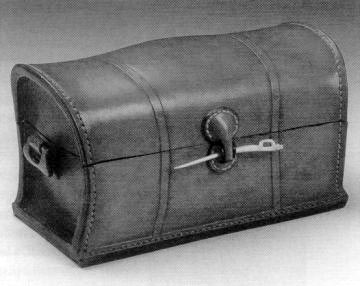|
|
 |
|
Robert Muma: Binding Godfather
A brief biography of Robert Muma's
bookbinding career
from the book: A Fine Line - Studio Crafts in Ontario from 1930 to the
Present, by Gail Crawford
The acknowledged father of Canadian binding, Robert Muma of Coldstream and
Toronto, got his start after World War II when he and his wife operated a
leathercraft school, Mumart, from their Hazelton Avenue home, which drew
students from Canada and northern United States. Mainly hobbyists, his pupils
learned how to fashion handbags, wallets, belts, bookmarks, picture frames, and
other accessories that were then all the vogue. Leather courses, in fact, were
for a time a veritable staple of night-school programs. With a circle of more
serious enthusiasts, Muma formed the Canadian Society for Creative Leathercraft
in 1950 to improve standards of craftsmanship and promote more original design
concepts. |
|
 |
Completing a commission in his Hazelton Avenue studio,
bookbinder Robert Muma, by 1977, was ready to retire from the
limelight after more than thirty years as a pioneer in restoring and
binding books. |
|
| |
| The craft of bookbinding had always fascinated Muma, and he had worked
briefly in a binding factory, but it was not until he acquired the requisite set
of European tools that he was able to become a full-time hand-binder and
restorer, eventually one of Canada's finest in private practice. While building
his clientele, he continued to teach small classes of seasoned leathercrafters
who had also become intrigued with quality bookbinding. At the relatively senior
age of fifty-two, Muma received the first scholarship established by the
Canadian Handicrafts Guild's Women's Committee to assist with further study. He
used the thousand-dollar stipend - an amount made possible by Douglas Duncan's
matching donation - to gain mastery of the exacting technique of gold-tooling
and gilt-edging at Columbia University, New York City. In North America's
bookbinding field, gold work was an uncommon hand-specialty, because procedures
were not written and could only be learned orally from experts. On his return to
Toronto in spring 1960, Muma savoured a heightened reputation for what Michael
Wilcox terms his inventiveness and artistry, not to mention his contagious
enthusiasm. Now more refined, his hand-bound volumes were sought after as gifts
and commemorative pieces for corporations, institutions, and royal visitors.
Assisted by occasional apprentices, and Michael Wilcox for a spell in 1963, Muma
continued in the profession until the late Seventies when he sold his equipment
and returned to a first love, botany, combining it with watercolour painting. |
| |
|
Made by Robert Muma in the late Seventies, for his own
use, this replica of a pirate's treasure chest is 26 x 14 x 14.5 cm
of molded and baked cowhide, hand-stitched, hinged, and latched with
a miniature bone sword. |

|
|
| |
Reproduced from the book: A Fine Line -
Studio Crafts in Ontario from 1930 to the Present, by Gail Crawford
Copyright © Gail Crawford |
|
|
|